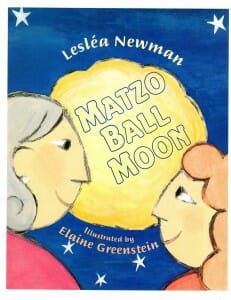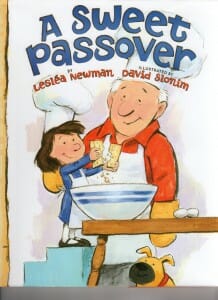 If someone mentions the word Passover, I immediately think of all of the special foods that are eaten during the holiday. Thus, I was immediately drawn to two picture books by Lesléa Newman– Matzo Ball Moon (Clarion, 1998) and A Sweet Passover (Abrams, 2012).
If someone mentions the word Passover, I immediately think of all of the special foods that are eaten during the holiday. Thus, I was immediately drawn to two picture books by Lesléa Newman– Matzo Ball Moon (Clarion, 1998) and A Sweet Passover (Abrams, 2012).
In Matzo Ball Moon, the reader learns about the Jewish custom of making chicken soup with matzah balls. As the grandmother, mother, and young daughter work together in the kitchen, readers can sense the closeness between the generations. This intergenerational component illustrates the benefit of having a grandparent who can share family traditions.
The story highlights some of the parts of a Passover Seder while simultaneously showing the interaction between the family members. Prior to the beginning of the Seder, various family members are delighted to sneak a tempting matzah ball from the kitchen.
By the time the soup is ready to be served, there are not enough matzah balls for everyone. The grandmother does not have one. Despite everyone’s offers to share, the grandmother is content. She candidly remarks, “ Eat up, all of you. As long as my family enjoys, I enjoy.”
At the end of the story, the young girl compares the moon to matzah balls. The grandmother and the granddaughter stand outside and admire their matzah ball in the sky.
Elaine Greenstein’s simple drawings add to the understanding of the story. At the end of the book, Leslea includes basic information about Passover that is useful for anyone unfamiliar with the holiday or the special vocabulary.
The intergenerational component continues in A Sweet Passover. This time, the setting is in the grandparent’s house. The young girl in this story recounts all of the things that she loves about Passover and the different things she eats with matzah. At the end of the holiday, she is tired of eating matzah. Like many observant Jews, she longs for the bread products that have been prohibited during Passover.
On the last day of Passover, the girl watches her grandfather make matzah brei. Everyone is delighted to eat this traditional food with his/her own topping. She would prefer not to eat anymore matzah. After each of the family members provides his/her explanation for why Jews should eat matzah during Passover, the girl humbly asks her grandfather to make more matzah brei. This time around they work together to create the food.
Each page has a delightful drawing by David Slonim that captures the sentiments of the characters. Leslea includes a lengthier explanation of Passover in the Author’s Note and also provides a glossary for the Hebrew and Yiddish terms that are used in the book.
Both picture books tell a family orientated story that revolves around the celebration of Passover Jewish readers will be able to connect with the traditions and the Yiddish and Hebrew words. I couldn’t wait to make my version of matzah brei as soon as I finished the book. Non-Jewish readers will be introduced to Jewish customs and will learn additional information from the notes at the end. If you are looking for a family orientated Passover picture book, consider one or both of Leslea’s charming books.
Book Giveaway
Anyone who leaves a comment on this blog by Sunday, April 20 will be eligible for a book giveaway. The randomly selected winner will be sent an autographed copy of one of these Passover books from Lesléa Newman.
Related Blogs:
Picture Books for the High Holidays
Holocaust Picture Book Illustrates lost European Synagogues
Two Jewish Children’s Books for Thanksgiving
Multicultural Picture Book- Benjamin of Tudela
Sandra’s Bio


I would be so honored to read one of Leslea’s books to the young children in my life…to bring further meaning of the holiday to those little Jewish kids and to bring new meaning of the holiday for those non-Jewish kids who will grow more tolerant as they are introduced to the customs of other cultures. Leslea is an old friend and I’d love to add one of these books to my growing collection of her books on my bookshelf!